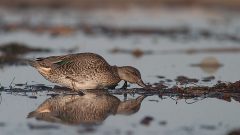American Wigeon Photo Gallery
Male
A compact duck with a short, pale bill and a round head. Breeding males have a brownish gray head with a wide green stripe behind the eye and a white cap.
© Karl Krueger / Macaulay LibraryMaryland, February 06, 2016Female
Females have a warm brown body with a brownish gray head and a dark smudge around the eye. Note the pale bill tipped in black.
© Alix d'Entremont / Macaulay LibraryNova Scotia, February 28, 2015Female
Dips bill in water to pick up aquatic plants and insects from the surface or tips up to pluck submerged vegetation.
© Eric Liner / Macaulay LibraryAlaska, June 20, 2007Not all videos have soundAdult male
In flight males show a prominent white patch on the upperwing, green secondaries, and white under the wing.
© Alix d'Entremont / Macaulay LibraryNova Scotia, February 28, 2015Eclipse male
Nonbreeding males have a reddish brown body with a brownish gray head and a dark smudge around the eye. The prominent white patch in the wing and green secondaries may not always be visible.
© Esme Rosen / Macaulay LibraryCalifornia, September 23, 2012Breeding male and female
Eats primarily vegetation such as duckweed, pond weed, water milfoil, and wigeon grass during the nonbreeding season.
© Jay McGowan / Macaulay LibraryNew York, November 08, 2014Not all videos have soundMale
In some lights the green head stripe can look bronzy.
© Sherrie Quillen / Macaulay LibraryTennessee, December 10, 2016Male and female
Uses its short gooselike bill to pluck vegetation and seeds from fields and pastures.
© Jay McGowan / Macaulay LibraryNew York, March 19, 2015Not all videos have soundMale
A small number of males have white on the cheeks and throat, which hunters often refer to as a "storm wigeon."
© Joshua Glant / Macaulay LibraryWashington, December 10, 2017Breeding male and female
Pairs form on the wintering ground and stay together throughout most of incubation.
© Timothy Barksdale / Macaulay LibraryOregon, March 20, 2001Not all videos have soundFlock
Often occurs in flocks during the nonbreeding season. Found in a wide variety of wetland habitats including lakes, wetlands, and flooded farm fields.
© Diane Drobka / Macaulay LibraryArizona, December 27, 2020Compare with Similar Species
Click on an image to compare
Species in This Family
Ducks, Geese, and Waterfowl(Order: Anseriformes, Family: Anatidae)
More to Read
Don't miss a thing! Join our email list
The Cornell Lab will send you updates about birds,
birding, and opportunities to help bird conservation.


























































